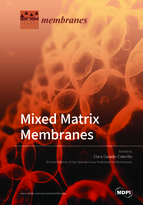Mixed Matrix Membranes
A special issue of Membranes (ISSN 2077-0375). This special issue belongs to the section "Membrane Analysis and Characterization".
Deadline for manuscript submissions: closed (15 May 2018) | Viewed by 38995
Special Issue Editor
Interests: synthesis; characterization; CO2 capture and utilization; mixed matrix membranes; pervaporation; sustainable process intensification using membranes
Special Issues, Collections and Topics in MDPI journals
Special Issue Information
Dear Colleagues,
This Special Issue, entitled “Mixed Matrix Membranes”, is motivated by the gap between growing interest in developing novel mixed matrix membranes by various research groups and the lack of large-scale implementation. This includes important issues regarding fabrication, such as compatibility and adhesion, fabrication (solution casting, dip-coating, spinning, interfacial polymerization, layer-by-layer, etc.), configuration, geometry (flat-sheet, hollow fiber, composite, asymmetric), post-treatment, types of additives/fillers (zeolites, ionic liquids, ion-exchange materials, layered porous materials, MOFs, etc.), and reproducibility, membrane characterization (e.g., chemical, structural, morphological, electrical, compositional, mechanical and topographical properties, as well as membrane transport and separation), and applications of membranes in different fields, especially in CO2 separation from other gases, with a special focus on the influence of impurities, such as water vapor and ion exchange membranes for several electrochemical devices, such as innovative energy storage systems. Overall, this Special Issue is orientated to all the above-cited research topics, directed to the advancement of mixed matrix membranes and novel materials in membrane technology to solve some of the environmental and technical challenges faced by chemical industries.
Dr. Clara Casado Coterillo
Guest Editor
Manuscript Submission Information
Manuscripts should be submitted online at www.mdpi.com by registering and logging in to this website. Once you are registered, click here to go to the submission form. Manuscripts can be submitted until the deadline. All submissions that pass pre-check are peer-reviewed. Accepted papers will be published continuously in the journal (as soon as accepted) and will be listed together on the special issue website. Research articles, review articles as well as short communications are invited. For planned papers, a title and short abstract (about 100 words) can be sent to the Editorial Office for announcement on this website.
Submitted manuscripts should not have been published previously, nor be under consideration for publication elsewhere (except conference proceedings papers). All manuscripts are thoroughly refereed through a single-blind peer-review process. A guide for authors and other relevant information for submission of manuscripts is available on the Instructions for Authors page. Membranes is an international peer-reviewed open access monthly journal published by MDPI.
Please visit the Instructions for Authors page before submitting a manuscript. The Article Processing Charge (APC) for publication in this open access journal is 2700 CHF (Swiss Francs). Submitted papers should be well formatted and use good English. Authors may use MDPI's English editing service prior to publication or during author revisions.
Keywords
- Membrane fabrication
- Membrane modification
- Characterization techniques
- Flat-sheet membrane
- Hollow fiber membrane
- Spinning
- Filler dispersion
- Interfacial polymerization
- Compatibility
- Gas separation
- Ion exchange membranes
- Ion exchange capacity
- Water vapour







